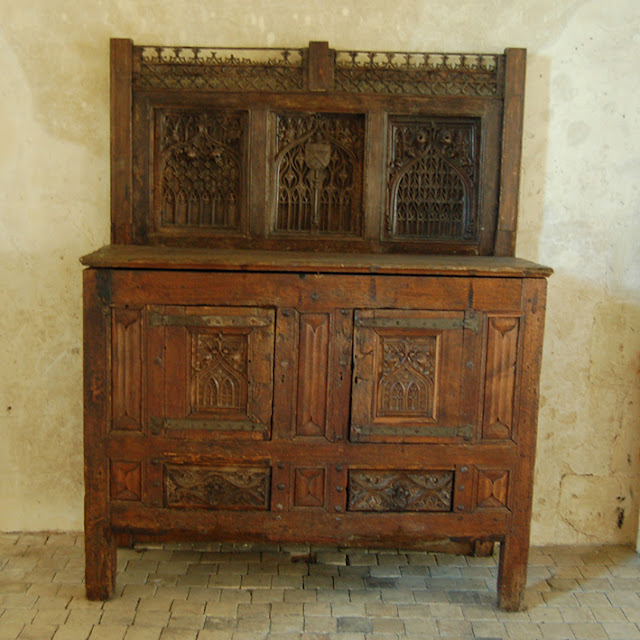This time I will show photos I made from the
Imperial Treasury in the Höfburg, the
MAK (Museum für Angewandte Kunst) and the Kunstkammer in the
Kunst Historische Museum. Especially the Imperial treasury did have a stunning collection of medieval clothing, including gloves and socks. This set of medieval clothes was actually the coronation dress of King William II of Sicily, which later were used for the emperor of the Holy Roman Empire (also the other regalia can be seen in the treasury).
Starting with the underwear, the Alba
of the coronation clothes was made in 1181 in Palermo - according to the
embroidered text on the cloth in both Latin and Arabic - for King William II. It is worn
underneath the Dalmatica. As I could not make a decent photo of it, this one was retrieved from internet.
Over the Alba, the Dalmatica, also called blue Tunicella, was worn. The gown was also made in
Palermo, Sicily in 1140 and belongs to the coronation clothing, and later of
that of the emperors of the Holy Roman Empire. It is made of dark blue Samite silk; the red silk at the end of the arms and the underside of the gown is the same cloth as coronation mantle, decorated with rows of pearls and gold embroidery.
Detail of the arm of the blue Dalmatica.
The coronation mantle or Pluviale is worn over the blue Tunica. It was also made in Palermo in the Royal Workshop around 1133/1134. The mantle is made from red Samite
silk with gold silk embroidery, pearls, enamel, filigree gold, precious
stones and a tablet weave at the edge.
The hands were covered with gloves. These were made in Palermo, Sicily, Italy before 1220 from Samite silk and decorated with gold embroidery, enamel, niello, pearls and precious stones. They are part of the coronation clothes. The front (right) and back (left) of the gloves are shown.
The legs were covered with stockings or short hose. These were made from red Samite silk with embroidery of gold thread around 1150-1200 in the Court workshop in Palermo. The hose have a length of 60 cm and a diameter of 34 to 40 cm. The silk bands used to tighten are a later addition.
The feet and hose were covered by the shoes, also made from red Samite silk around 1130 or around 1220. The top of the shoes show a broad band of gold cloth covered with precious stones (in total 5 sapphires, 4 amethysts and one emerald) and medallions of griffins and sirens. The shoes have a length of 26 cm and a height of 10.8 cm, which equals size 41 in the Netherlands (or the UK size 7). The sole is made of leather. Also here I used a better photo from internet.
The Eagle Dalmatia is like the blue Tunicella worn over the Alba. This gown, decorated with eagle
medallions, was first mentioned in 1350 and is likely made around 1300
from Chinese damask (the fabric shows a Chinese cloud pattern) and black
silk. The gold embroidered edges are made from damask silk. The (imperial) eagle
medallions are stitched with black silk thread and have enamel eyes.
Originally also a hood belonged to this gown, which was lost when these
clothes were transported from Nürnberg to Vienna.
Not really clothing, but an accessory to put on clothing, although there is actually some clothing on this brooch. The brooch is Burgundian-Dutch and dates around 1430-1440. It is made from gold, enamel, precious stones and pearls.
These are 16th century Italian pontifical stockings made from red silk with gold embroidery. On display in the MAK.
Thes
are images from the Vienna model book of around 1410. This booklet with
a leather case contains many silverpoint drawings on paper of animals,
men and godly creatures. The model book was used by painters as some
sort of reference book. Some of the drawings show different types of
head-wear, such as those shown in this photo. Kunstkammer,
Kunst-Historisches Museum.
This is the complete set of the model book with leather casing. Photo from the KHM.
In the Kunstkammer of the Kunst-Historisches Museum was a late 15th century bust of a female by Francesco Laurana with an intricate hair net with (gold) latticework decorated with red flowers. The bust could perhaps depict Ippolita Maria Sforza or her daughter Isabella.
Also in this museum is a statue of 'vanitas' by Michel Ehrhart, made from linden wood around 1470-1480. It figures a young couple and an old wife. What is most intriguing is that the only piece of clothing is a piece of male string underwear (both women are naked), fastened with a bow!
Finally, something else:
This 15th century 'Saintly' beer glass was also on display in the MAK. Cheers Thomas!































































